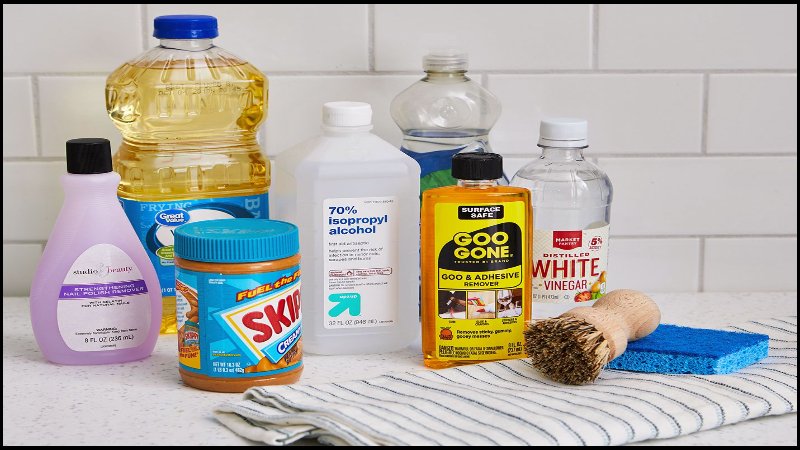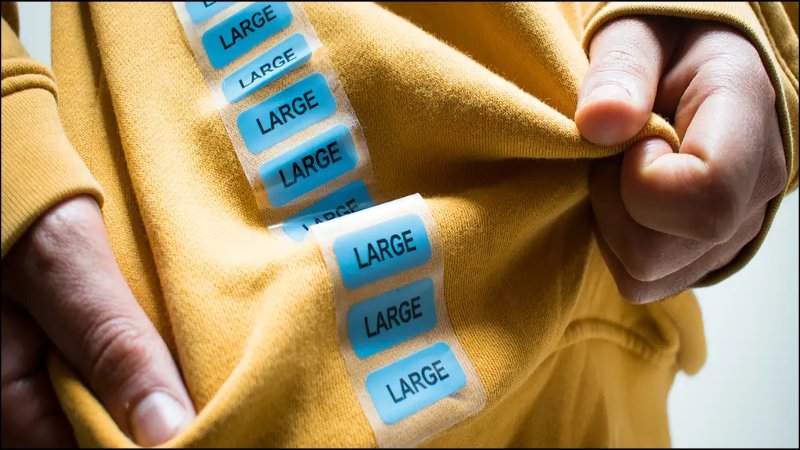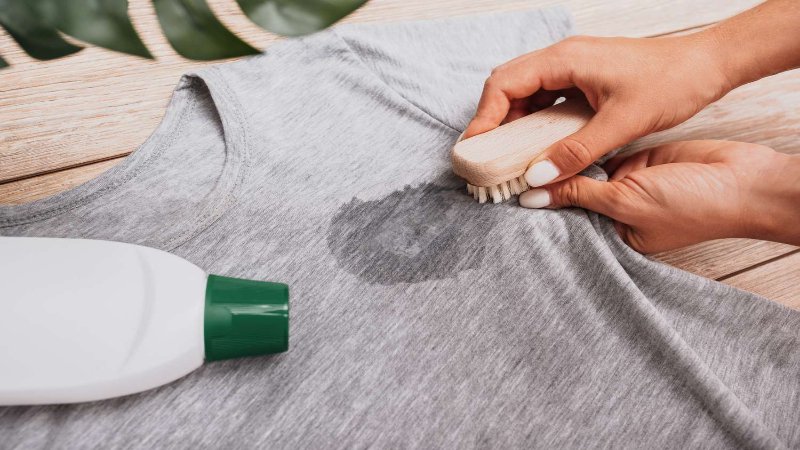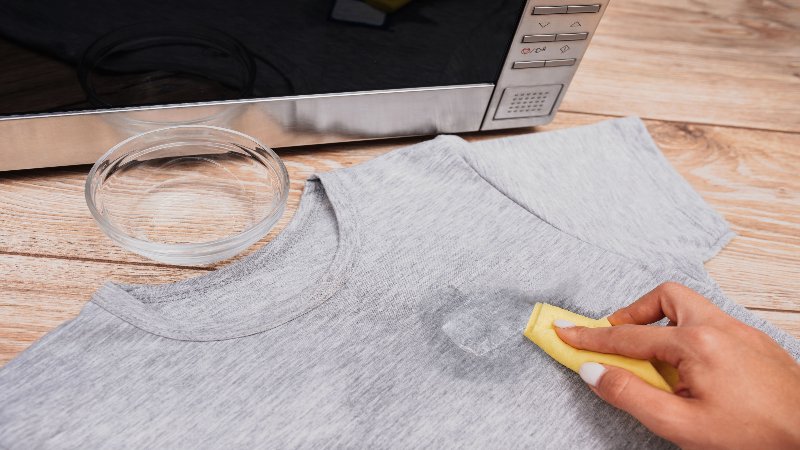Remove Sticky Label Residue: Fabric-Safe Methods
That stubborn, sticky residue left behind by price tags, stickers, or labels can be a real annoyance. But before you reach for harsh chemicals, know that there are several fabric-safe methods for removing label residue without damaging your clothes.
This guide provides a range of solutions, from simple household items like dish soap and rubbing alcohol to commercial adhesive removers, along with clear, step-by-step instructions. You’ll learn how to tackle even the most persistent sticky mess and restore your fabrics to their pristine condition.
1. Understanding Sticker Residue and Fabric Types
1.1 Why is Sticker Residue So Stubborn?
Sticker residue is notoriously persistent because of the chemical composition of the adhesives used. These adhesives are typically made up of polymers and resins that are designed to create a strong bond.
- Polymers: These are long chains of molecules that give the adhesive its strength and flexibility.
- Resins: These are sticky substances that help the adhesive adhere to surfaces.
When you apply a sticker to fabric, the adhesive interacts with the fabric fibers. Washing and drying a garment with a sticker still attached can make the problem worse. The heat and water can cause the adhesive to:
- Spread: The adhesive can soften and spread further into the fabric.
- Bond more tightly: The heat can essentially “bake” the adhesive onto the fabric fibers, making it like glue that’s permanently set.
This is why simply washing a garment often doesn’t remove sticker residue – and can sometimes make it even harder to get rid of.

1.2 Fabric Matters: Different Approaches for Different Materials
Different fabrics have different properties and tolerances. What works well on one fabric might damage another. Always check your garment’s care label before attempting any residue removal method. The care label provides valuable information about the fabric’s composition and any cleaning restrictions.
1.3 Cotton and Cotton Blends
Cotton is a relatively durable fabric that can generally withstand a variety of cleaning methods. It’s often safe to start with gentler approaches like ironing (with parchment paper) or applying rubbing alcohol. If these methods don’t work, you can progress to stronger options, always testing on an inconspicuous area first.
1.4 Polyester and Synthetics
Synthetic fabrics like polyester are often more sensitive to heat than cotton. Avoid using high heat settings on your iron, as this could melt or distort the fibers. Solvent-based methods (rubbing alcohol, adhesive removers) are often a better choice for synthetics, but always test first, as some chemicals can damage or discolor these materials.
1.5 Delicate Fabrics (Silk, Wool, Lace)
Delicate fabrics require the utmost care. Avoid harsh chemicals, excessive rubbing, or high heat. Start with the gentlest methods possible, such as freezing (to make the adhesive brittle) or applying a very mild solvent like diluted dish soap. Always test any method on a hidden area first, and if you’re unsure, consult a professional dry cleaner.

1.6 Denim
Denim is a sturdy, robust fabric that can usually tolerate most residue removal methods. You can try ironing (with parchment paper), rubbing alcohol, or even stronger adhesive removers. However, it’s still a good idea to start with gentler methods and test in an inconspicuous area, especially with lighter-wash denims, which may be more prone to discoloration.
1.7 Other Materials (Leather, Suede)
Leather and suede are not fabrics and require specialized care. Do not attempt to remove sticker residue from leather or suede using DIY methods. These materials are easily damaged by water, heat, and solvents. Take the item to a professional leather or suede cleaner for safe and effective residue removal.
2. Methods for Removing Sticky Labels from Clothes
2.1 Method 1: The Ironing Technique (For Heat-Safe Fabrics)
This method uses heat to soften the adhesive, making it easier to lift off the fabric. It’s best suited for durable fabrics like cotton, denim, and some polyester blends that can withstand heat. Always check the garment’s care label first.
Steps:
- Prepare: Place a clean paper towel under the garment, directly beneath the area with the residue. This will absorb the softened adhesive.
- Protect: Place two layers of clean paper towels on top of the residue. This prevents the adhesive from sticking to your iron.
- Heat: Set your iron to a low or medium heat setting, with no steam.
- Apply: Gently press the iron onto the paper towels covering the residue. Hold it in place for 5-10 seconds.
- Lift: Remove the iron and quickly, but carefully, use your fingernail, a dull plastic scraper (like a credit card), or tweezers to lift the softened residue from the fabric.
- Repeat: Repeat steps 4 and 5 until the residue is completely gone. You may need to replace the paper towels if they become saturated with adhesive.
2.2 Method 2: Using Solvents (Rubbing Alcohol, Vinegar, etc.)
Solvents can help dissolve the adhesive, making it easier to remove. However, always test solvents on an inconspicuous area first, as they can damage or discolor some fabrics. Always Test Solvents in an Inconspicuous Area: Before applying any solvent to the visible part of the garment, test it on a hidden area like the inside of a hem or seam. Apply a small amount of the solvent, wait a few minutes, and check for any discoloration, damage, or texture changes.

2.2.1 Rubbing Alcohol
Steps:
- Test: Test on an inconspicuous area first.
- Apply: Apply a small amount of rubbing alcohol to a clean cloth or cotton ball.
- Dab: Gently dab the residue with the alcohol-soaked cloth. Do not rub aggressively.
- Wait: Let the alcohol sit for a few minutes to soften the adhesive.
- Lift: Use your fingernail, a dull plastic scraper, or tweezers to lift the softened residue.
- Wash: Wash the garment as usual, according to its care label.
2.2.2 White Vinegar
Steps:
- Test: Test on an inconspicuous area first.
- Dilute (Optional): For delicate fabrics, you may want to dilute the vinegar with an equal amount of water.
- Apply: Apply a small amount of white vinegar (diluted or undiluted) to a clean cloth.
- Dab: Gently dab the residue with the vinegar-soaked cloth.
- Wait: Let it sit for 15-30 minutes.
- Lift: Use a fingernail to lift the residue.
- Wash: Wash the garment as usual.
2.2.3 Commercial Adhesive Removers
Steps:
- Test the product.
- Apply directly to the residue.
- Wait for the time shown on the product instruction
- Use a fingernail to lift the residue.
- Wash the garment

2.3 Method 3: The Freezing Method (For Gum-Like Residue)
Freezing can be effective for removing residue that has a gum-like or waxy consistency. The cold temperature makes the adhesive brittle and easier to scrape off.
Steps:
- Bag it: Place the garment in a plastic bag, making sure the residue is not touching other parts of the garment.
- Seal: Seal the bag tightly.
- Freeze: Place the bag in the freezer for 1-2 hours, or until the residue is completely frozen solid.
- Remove: Remove the garment from the freezer.
- Scrape: Immediately try to peel or scrape off the hardened residue using your fingernail, a dull plastic scraper, or the edge of a credit card. Work quickly before the residue has a chance to soften.
- Wash: Wash it
2.4 Method 4: Using Oils (Vegetable Oil, Baby Oil)
Oils can sometimes help to loosen adhesive residue, but they also carry a risk of staining, so use this method with caution.
Steps:
- Test: Test on an inconspicuous area first.
- Apply: Apply a small amount of vegetable oil or baby oil to the residue.
- Wait: Let the oil sit for about 30 minutes to penetrate the adhesive.
- Scrape: Gently scrape off the softened residue with your fingernail or a dull plastic scraper.
- Wash: Thoroughly wash the garment with laundry detergent and warm water to remove all traces of the oil. You may need to wash it multiple times.
2.5 Method 5: Pre-Treating Solutions
Use laundry stain removers to remove the residue. Apply directly on the residue, and follow the product instruction.
3. Troubleshooting: What if the Residue Remains?
Sometimes, even after trying a removal method, some sticky residue might persist. Don’t despair! Here are some steps you can take:
- Repeat the Method: If you saw some improvement with the initial attempt, try repeating the same method. Sometimes, multiple applications are needed, especially for stubborn or dried-on residue.
- Try a Different Method (Safely): If one method isn’t working, consider trying a different one, provided it’s safe for your fabric. For example, if rubbing alcohol didn’t work, you might try a commercial adhesive remover (always testing on an inconspicuous area first).
- Combine Methods (with Caution): In some cases, combining methods can be effective. For example:
- Freezing followed by a solvent: Freeze the garment to make the residue brittle, then try applying a solvent to dissolve any remaining adhesive.
- Heat followed by a solvent: Apply heat with the ironing method to soften the residue, then try using a solvent.
4. Preventing Sticker Residue on Clothes
The best way to deal with sticker residue is to prevent it from happening in the first place:
- Remove Stickers Before Washing: Make it a habit to remove all price tags, stickers, and temporary labels from clothing before washing and drying. The heat and water from the washing and drying process can make the residue much harder to remove.
- Use Designated Sticker Areas: If you need to temporarily label clothing (e.g., for a child’s camp or a school event), consider using a designated area that won’t leave residue. For example:
Use the care tag for temporary labeling with a safety pin and a small piece of paper, rather than sticking something directly to the fabric. Use masking tape, but only for the short-term. Always check the care label before applying or removing anything from a garment. The care label provides valuable information about the fabric’s composition and any cleaning restrictions.
5. Related Questions
5.1 How do I remove sticker residue from clothes without an iron?
If you don’t have an iron or are dealing with a heat-sensitive fabric, you have several options. You can try using solvents like rubbing alcohol (test on a hidden area first!), white vinegar, or a commercial adhesive remover.
The freezing method, where you place the garment in the freezer to make the residue brittle, can also be effective. In some cases, applying a small amount of oil (like vegetable oil or baby oil) can help loosen the residue, but be sure to wash the garment thoroughly afterward to remove any oil stains.
5.2 Can I use nail polish remover to remove sticker residue from clothes?
Generally, no. Nail polish remover often contains acetone, a strong solvent that can damage or discolor many fabrics, especially delicate ones like silk, acetate, and rayon. It can also dissolve some synthetic fibers. While acetone can be effective at removing adhesive, the risk of damaging your clothes is usually too high. It’s much safer to use gentler alternatives like rubbing alcohol or a specialized adhesive remover.
5.3 What’s the best way to remove price tag residue from new clothes?
Start with the gentlest methods. Try rubbing the residue with your fingers or a soft cloth to see if it will come off. If that doesn’t work, try applying a small amount of rubbing alcohol or even a bit of vegetable oil or baby oil to the residue, letting it sit for a few minutes, and then gently rubbing or scraping. Always test any method on an inconspicuous area of the garment first.
5.4 How to remove sticker residue from a washing machine?
If sticker residue has ended up inside your washing machine (often from a sticker accidentally left on clothing), you can try wiping the affected area with a cloth dampened with rubbing alcohol. For stubborn residue, you might consider using a commercial adhesive remover, following the product instructions. Make sure to rinse the area thoroughly with water afterward.
5.5 How to remove iron-on sticker of clothing?
The most common method is to reapply heat. Turn the garment inside out, place parchment paper inside the garment and over the back of the sticker, and then press a warm iron (low to medium heat, no steam) onto the parchment paper for 10-15 seconds. This should soften the adhesive.
Then, carefully try to peel the sticker off using tweezers. If this doesn’t work, you may need to consider using a solvent after trying the heat method, but always test on a hidden area first. Refer to the full article for detailed instructions on using heat and solvents.
Read more:
Removing sticky label residue from clothes can seem daunting, but with the right approach, it’s usually manageable. Remember that multiple methods exist, including ironing, using solvents, freezing, and applying oils. The best method for you will depend on the type of fabric you’re dealing with and the nature of the residue.
Always test any method on an inconspicuous area first, and be patient – you may need to repeat steps or try different techniques. Prevention is always the best approach, so make it a habit to remove stickers and price tags before washing your clothes. With a little care and these helpful tips, you can keep your garments free from sticky residue and looking their best. For further information, check out fabric care guides!






















